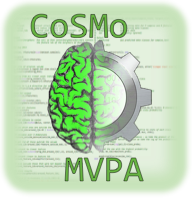run spherical neighborhood searchlight¶
- run_up:
run_spherical_neighborhood_searchlight
%% Spherical searchlight
% this example implements a spherical searchlight using
% cosmo_spherical_neighborhood and performs crossvalidation
% with a nearest neigh classifier
%
% Note: for running searchlights it is recommended to use
% cosmo_searchlight and cosmo_spherical_neighborhood
%
% # For CoSMoMVPA's copyright information and license terms, #
% # see the COPYING file distributed with CoSMoMVPA. #
%% Set up parameters
config = cosmo_config();
data_path = fullfile(config.tutorial_data_path, 'ak6', 's01');
output_path = fullfile(config.output_data_path);
fn = fullfile(data_path, 'glm_T_stats_perrun.nii');
maskfn = fullfile(data_path, 'brain_mask.nii');
radius = 3;
targets = repmat(1:6, 1, 10);
chunks = floor(((1:60) - 1) / 6) + 1;
classifier = @cosmo_classify_nn;
classifier_opt = struct();
%% load data and set sample attributes
ds = cosmo_fmri_dataset(fn, 'mask', maskfn, ...
'targets', targets, ...
'chunks', chunks);
fprintf('Input dataset:\n');
cosmo_disp(ds);
%% define centers of searchlight
nfeatures = size(ds.samples, 2);
center_ids = 1:nfeatures;
%% use voxel selection function
nbrhood = cosmo_spherical_neighborhood(ds, 'radius', radius);
center2neighbors = nbrhood.neighbors;
ncenters = numel(center2neighbors); % should be equal to 'nfeatures'
%% set up cross validation
% (here we use cosmo_oddeven_partitioner; cosmo_nfold_partitioner would be
% another possibility, with the advantage of using a larger training set,
% but the disadvantage that it takes longer to run)
partitions = cosmo_oddeven_partitioner(ds);
%% Allocate space for output
ncenters = numel(center_ids);
accs = zeros(1, ncenters);
%% Run the searchlight
% go over all features: in each iteration, slice the dataset to get the
% desired features using center2neighbors, then use cosmo_crossvalidate
% to get classification accuracies (it's its second output argument),
% and store the classiifcation accuracies.
%
% Note: it is generally easier (and faster) to use cosmo_searchlight
% and cosmo_crossvalidation_measure; this example here is for
% illustrative purposes mainly
% use cosmo_show_progress to show a pretty progress bar
prev_msg = '';
clock_start = clock();
show_progress_every = 1000;
for k = 1:ncenters
center_id = center_ids(k);
sphere_feature_ids = center2neighbors{center_id};
sphere_ds = cosmo_slice(ds, sphere_feature_ids, 2);
% run cross validation
[pred_cv, acc] = cosmo_crossvalidate(sphere_ds, classifier, ...
partitions, classifier_opt);
% for now, just store the accuracy (not the predictions)
accs(center_id) = acc;
% show progress every 1000 steps, and at the beginning and end.
if k == 1 || mod(k, show_progress_every) == 0 || k == nfeatures
mean_so_far = mean(accs(1:k));
msg = sprintf('accuracy %.3f (%d features visited)', mean_so_far, k);
prev_msg = cosmo_show_progress(clock_start, k / ncenters, msg, prev_msg);
end
end
%% store the output
% this uses the neighborhood from spherical voxel selection,
% after removing the fields neighbors and origin
res_map = nbrhood;
res_map = rmfield(res_map, {'neighbors', 'origin'});
res_map.samples = accs;
res_map.sa = struct();
% little sanity check
cosmo_check_dataset(ds);
fprintf('Output dataset:\n');
cosmo_disp(res_map);
output_fn = fullfile(output_path, 'spherical_neighborhood_searchlight.nii');
cosmo_map2fmri(res_map, output_fn);
fprintf('Output written to %s\n', output_fn);
%% Plot a few slices
cosmo_plot_slices(res_map);

